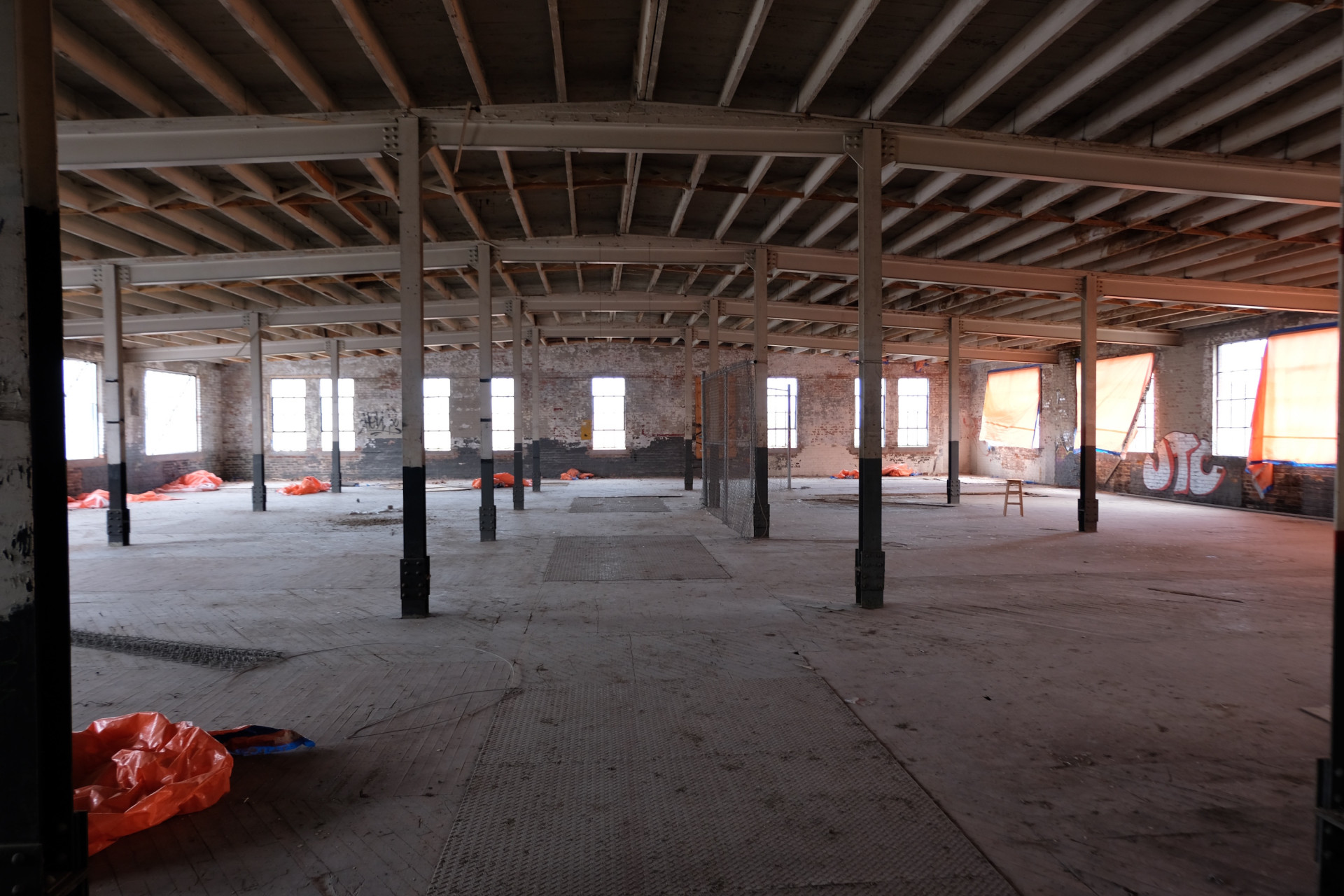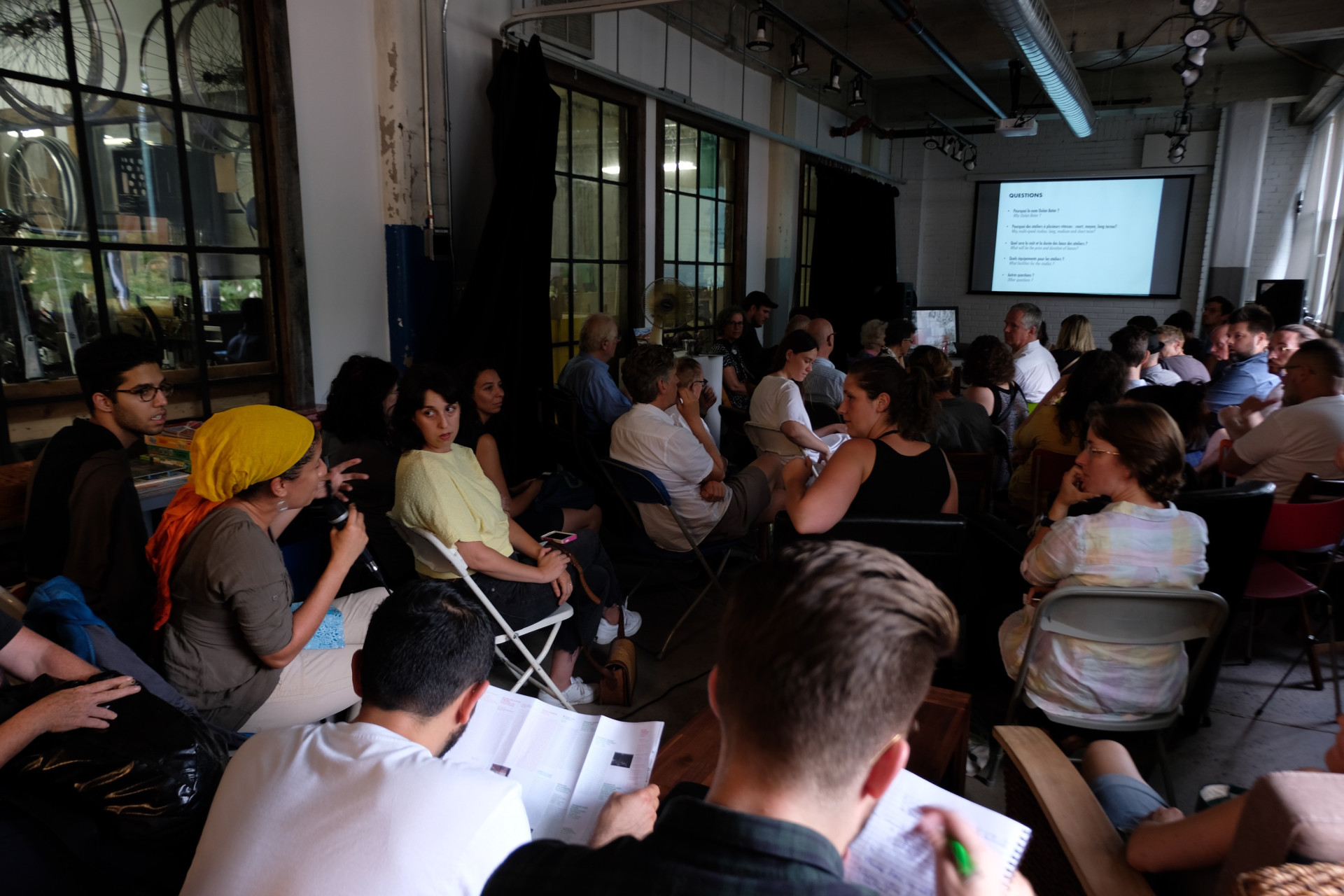AN ALTERNATIVE VISUAL ARTS CENTRE IN TWO RAILCARS: ARTIST STUDIOS AND CULTURAL MEDIATION HUB
Quartier Éphémère’s new project at Bâtiment 7 (Building 7), located in a former rail yard in Pointe-Saint-Charles, consists in creating an alternative visual arts centre that has with two components: a creation and production hub for professional visual artists and an educational hub dedicated to disseminating their work and raising public awareness of contemporary art practices. Established in 1993 in the South-West borough, Pointe-Saint-Charles district, Quartier Éphémère is a charitable non-profit organization known for educating the public about contemporary art. Having managed the Darling Foundry for seventeen years, the organization is constantly seeking to expand its support of artists and increase public awareness of art. Quartier Éphémère’s new project brings an actual creative aspect as well as a significant urban outreach to Building 7, in a neighbourhood sorely lacking in art spaces. The project seeks to further some of the organization’s key values such as openness and inclusion, tolerance, equality, the strengthening of individual identity, knowledge- and resource-sharing.
A Train with Two Railcars
In line with the organization’s model of renovating brownfield sites into art spaces, Quartier Éphémère launches an innovative project that will offer new prospects to artists and provide a novel framework for an entire neighbourhood. By increasing the number of artist studios offered and creating a new space intended for a diverse public within the stimulating environment of a community project, the organization seeks to create a true artistic, economic, and social seedbed that is open to its neighbourhood and the world at large.
First Railcar: Artist Studios
Montreal artists critically need work spaces as the city’s gentrification gradually chases them out of the industrial spaces they were previously able to occupy. Quartier Éphémère’s project at Building 7 solidifies their presence in an industrial heritage building. The studios are intended for professional visual artists in Montreal, namely those who make, or seek to make, art their fulltime profession. Offered in various surface areas at affordable rates, these spaces make it possible for artists to carry out their work under optimal conditions—in terms of volume, light, accessibility—in an environment that is conducive to inspiration and creation. The organization also plans to set up an artist studio co-op. Special attention will be given to artists, and all forms of visual and media art will be equally represented.
The organization’s objective is to serve as an incubator for artists by providing logistical support and an artistic framework so as to help them develop professional networks and advance their practices. It also aims to make their work conditions more stable by offering suitable and affordable spaces for extended periods of time. By serving the needs of artists, the organization seeks to strengthen their status, enhance their presence in neighbourhoods, and underscore the personal and social richness that their work can bring to a community. Being an artist is one of the least lucrative and most marginalized professions in our society. Yet artists are highly educated individuals with the ability to imagine a better world.
The proximity of the Practices Hub of Building 7, a project carried out by the 7 à Nous collective, offers invaluable production resources to artists: metal, wood, screen printing, digital printing, and ceramics shops. The synergy of this two-part project creates a very promising economic and social dynamic.
At the same time, the organization intends to coordinate a mediation platform between artists and the general public through the second railcar.
Second Railcar: Mediation Hub
The mediation hub will be a public and educational interface that develops various tools for reaching a diverse public:
- A multi-purpose room for presenting exhibitions, creative workshops, art talks, shows, and events;
- International studios for discovering international artists invited for short stays;
- A café/bookshop associated with a small, independent publishing house;
- Other activities organized outside the space.
Multi-Purpose Room
Quartier Éphémère will curate temporary visual art exhibitions for three to six months per year. The programming will focus on recent and historical examples of alternative art schools, whether realized or not.[1] Quartier Éphémère will cultivate partnerships with other visual art organizations, as well as present resident artists.
Various forums and discussions on artistic, heritage, political, anthropological, educational, and philosophical issues, among other topics, will be programmed. We envision the space as an open and critical site for bringing together a community of minds with diverse perspectives. Through these events, the room will become a gathering place for South-West artists, who will finally have the opportunity to meet and exchange ideas.
Between the programmed events, we will also organize creative workshops tailored to specific publics: children in the neighbourhood (daycares, schools, day camps), students (colleges and universities), elderly people (retirement homes, clubs, co-operatives), people with special needs (physical or mental disabilities, homeless). Artists will plan and prepare creative and skill-learning sessions based on the needs and requirements of the participants. The work resulting from the creative workshops could be subsequently presented as part of a temporary exhibition.
International Studios
The project promotes an internationally connected environment by hosting artists from anywhere around the world for short residencies in studio-residences designated for this purpose. These flexible studios can also be made available for short-term individual or group projects to places such as foreign universities, which can simultaneously occupy the multi-purpose room to develop projects with their students or to prepare a series of workshops or public talks that might resonate with the local community. In this regard, several universities have expressed interest in establishing research chairs.
Café/Bookshop
We also intend to provide space for a small, independent publishing house that specializes in artist books and author collections. As a storefront, it will serve as the neighbourhood bookshop, selling books about the art, history, and heritage of Pointe-Saint-Charles, civil movements and writers, as well as postcards. To make the atmosphere convivial and encourage return customers, we plan to set up a café that serves light meals.
Other Outreach Activities
As the main entrance of the multi-purpose room gives onto an open area, we feel inspired to extend our activities outdoors, where a public square can help us to connect with citizens. We will organize open studios on a regular basis, during which the general public can visit the artist studios and thus gain a better understanding of the work. In an effort to make our cultural activities even more dynamic, we also intend to carry out site-specific projects, namely temporary public art projects inside or outside the buildings or in parks, which are connected to the exhibitions on site and which combine the history of the neighbourhood—such as heritage buildings, cult spots, churches, parks, and the river—and contemporary art. In order to raise awareness and educate, it is important to make the building accessible and bring the art to the people.
Project History
Quartier Éphémère has been a partner of the Building 7 project from the outset. This grassroots project sought to reappropriate a building threatened by a powerful real estate developer and transform it into common property for the benefit of an entire neighbourhood. Through the long struggle, several organizations, including Quartier Éphémère, co-founded the 7 à Nous collective (a name which means “7 for us all”) to carry out the project. The initial vision was to provide local services, artist studios, and community outreach all under one roof.
The first victory was an agreement made with Groupe Mach to handover Building 7, thanks to the support of the South-West borough, the City of Montréal, and the collective’s determination. Quartier Éphémère assumed liability by signing a memorandum of understanding in September 2012. This document guaranteed the transfer of the building as well as the sum of $1 million to carry out emergency repairs.
In 2013, the contract was delayed by an unexpected negotiation between Groupe Mach and Canadian National. Aware of its liability as successor of a vacant building in light of its assets (the Darling Foundry), Quartier Éphémère assigned its rights to the 7 à Nous collective in 2014, with a reconveyance option for 43% of the building.
The 7 à Nous collective won a second victory by enforcing the acquisition and carrying out renovations on part of the building, which led to the opening of a grocery store, a brewpub, and a practices hub in 2018. Quartier Éphémère exercised its option on April 21, 2018 so as to become the owner of its part of the building (B3 and B4).
To ensure the project’s success, project management and architectural consultants carried out a feasibility study, a business opportunity study, and diligent inspections, financed by the City of Montréal and Canadian Heritage. As the recommendations were positive and the needs for artists and for the building’s preservation are pressing, the organization is pursuing its objective to assume ownership as soon as possible. The ideal implementation schedule is to begin the renovations in 2019 and open in September 2020.
History of Quartier Éphémère
Incorporated in 1993 in the South-West borough, Pointe-Saint-Charles district, Quartier Éphémère is a charitable non-profit cultural organization known for educating the public about contemporary art. Its mandate is to support the creation, production, and dissemination of artists in the visual arts. In keeping with its main objectives, the organization seeks to revitalize urban brownfields to fulfill its mission. In 1994, the first eponymous site opened at 16 Prince Street (1994–2000), then in 2002, the Darling Foundry was inaugurated. An art centre composed of two buildings, one dedicated to artist studios and the other to art exhibitions, the Darling Foundry remains active to this day. Other ad hoc projects, such as Panique au Faubourg (1997), Silophone (2000–2001), and Plan Large (2001–2009), have been developed in nearby brownfields. In 2007, the organization also began activating Place Publique in front of the Darling Foundry’s buildings.
Architectural Plan
(see attached plans)
The space sought by Quartier Éphémère is well-suited to a project with two components, as it is divided into two parts, B3 and B4.
In terms of spaces, the architectural plan for building B3 is divided as follows:
- 15 individual creation and production studios (professional artists in the visual and digital arts) of different surface areas (between 700 and 1500 sq. ft.);
- 5 offices for visual art research (art historians, exhibition curators, visual art NPOs, writers, between 260 and 300 sq. ft.);
- 3 common areas: two bathrooms and a kitchen (between 250 and 750 sq. ft.).
The organization plans to set up the following facilities in building B4:
- 1 multi-purpose room (2500 sq. ft.)
- 1 office for a publisher (750 sq. ft.)
- 1 small bookshop (500 sq. ft.)
- 1 café serving light meals (750 sq. ft.)
[1] Such projects include Gordon Matta-Clark’s centre for Loisaida (New York’s Lower East Side), Aleksandr Medvedkin’s Cine Train (the subject of Chris Marker’s 1971 film, The Train Rolls On), the Vitebsk School (1918–1922), and Black Mountain College (1933–1957).



